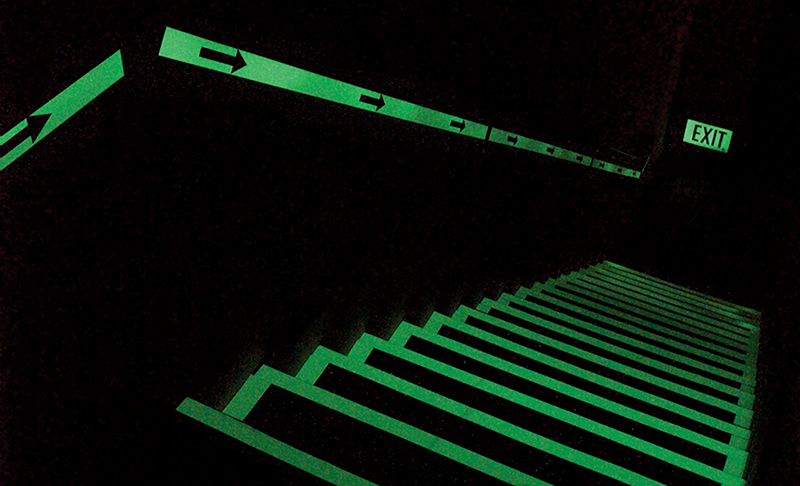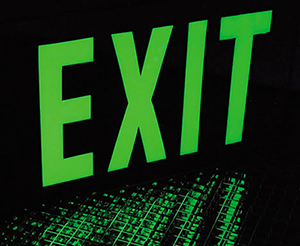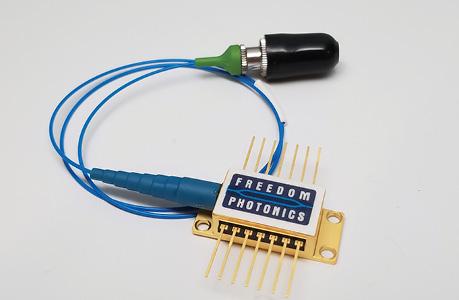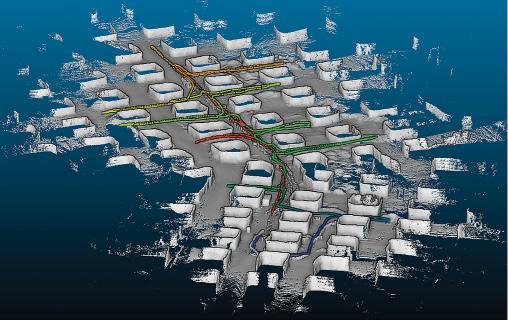
A Brighter Choice for Safety
Emergency exit signs can be lifesavers, but only if they remain visible when people need them. All too often, power losses or poor visibility can render the signs ineffective. Luna Technologies International, Inc., of Kent, Washington, is shining new light on this safety issue. The company's LUNAplast™ product line illuminates without the need for electricity, maintenance, or a power connection. LUNAplast, which benefited from tests conducted at Johnson Space Center, is so successful that NASA engineers selected it for the emergency exit pathway indicators on the International Space Station (ISS).
Available as rigid plastic and acrylic sheeting or flexible vinyl rolls, LUNAplast is an environmentally friendly material available in a full line of screen-printed emergency signs, directional markers, and international safety symbols. It can also be made into strips of various lengths and shapes for illuminating hallways, walkways, and other indoor or outdoor areas. The material is durable, ultraviolet-stable, and fire- and weather-resistant.
Luna Technologies' innovation is the result of advances in photoluminescent (PL) technology. PL materials contain inorganic phosphorescent pigments that absorb almost any kind of light, which is re-emitted when darkness occurs. The effect, called an afterglow, is bright enough to provide a yellowish-green illumination suitable for guiding someone out of a darkened area, such as a stairwell. The nonelectrical and nonradioactive glow is the brightest in the first few hours, but can be seen for days.
While commonly associated with "glow-in-the-dark" toys, PL technology has applications reaching far beyond the children's novelty toys that occasionally utilize it. PL lighting provides emergency exit systems for any setting in which safety is a concern, such as ships, hotels, manufacturing plants, office buildings, tunnels, and mines. As a nonelectric system, PL products provide a backup to standard electric emergency lighting systems.
The zinc sulphide (ZnS) compound used in most standard PL products typically has a limited capacity for storing light energy, causing the illumination to fade within 30 minutes. While many ZnS-based products are utilized in response to mandatory building and fire-safety codes, their limited illumination time curtailed wider voluntary use. LUNAplast changes that, as it emits light over 15 to 25 times brighter than standard PL products, for a significantly longer period of time. ZnS materials have illumination levels of 30 millicandellas to start, before degrading to .032 millicandellas, the lowest light threshold the human eye can perceive, in 3 to 6 hours. LUNAplast, on the other hand, delivers 400 to 600 millicandellas in the initial phase, lasting up to 30 hours before degrading to .032 millicandellas. LUNAplast's initial phase of illumination creates a level of visibility comparable to that produced by a typical electric exit sign.
Luna Technologies achieved this increase in LUNAplast's performance by learning to use strontium aluminate, a nonradioactive metal oxide compound with strong PL characteristics, as the raw material for the technical manufacturing process, in conjunction with the company's proprietary formulation and processing techniques. NASA also played a role in the material's advancement. The NASA Johnson Space Center Lighting Evaluation and Testing Facility tested LUNAplast in its search for a material to create the emergency placards required of the ISS crew member pathway indication system. Luna Technologies took the data from Johnson's tests to improve the product, leading to LUNAplast's selection for the ISS emergency placards.
LUNAplast products were recently installed on the lower walls and floors of the Pentagon as part of the renovation and reconstruction project that took place after the terrorist attacks on September 11, 2001. The supplemental signs mark building evacuation routes to help personnel leave quickly in case conventional electric exit signs lose power or are obscured by smoke, as was the case on September 11 when people faced power loss, darkness, and thick smoke. LUNAplast markings on office floorboards also help guide people who must stay low to the ground to exit. Evacuation maps produced from the glowing material are attached to each door, helping people to follow the escape route. Strips of LUNAplast outline door handles, and closet doors are marked as not being exits.
Luna Technologies produces the LUNAplast 2500 series, its benchmark product, as well as the new 5000 Sun Series. Applications for these products are taking PL technology beyond being a back-up system for electrical emergency exit systems. The LUNAplast EXIT sign meets the National Fire Protection Association's 101-Life Safety Code as a replacement for conventional exit signs, and the Underwriters Laboratory (UL), Inc., an independent, not-for-profit product safety testing and certification organization, lists the product in accordance with its UL 924 standard. This can mean significant savings for companies utilizing the new signs. According to Environmental Protection Agency statistics, installing the LUNAplast EXIT signs instead of electric ones can save a company $20,000 to $30,000 per year, based upon 1,000 electric exit signs. The signs also reduce initial hardware and installation costs, and provide environmental benefits from the reduced power consumption. Combining these savings with the product's life span of at least 25 years truly gives Luna Technologies a reason to glow.
LUNAplast™ is a trademark of Luna Technologies International, Inc.

LUNAplast™ EXIT signs illuminate without the need for electricity, maintenance, or a power connection.

LUNAplast™ material can be made into strips for illuminating hallways, stairwells, and emergency exits.













